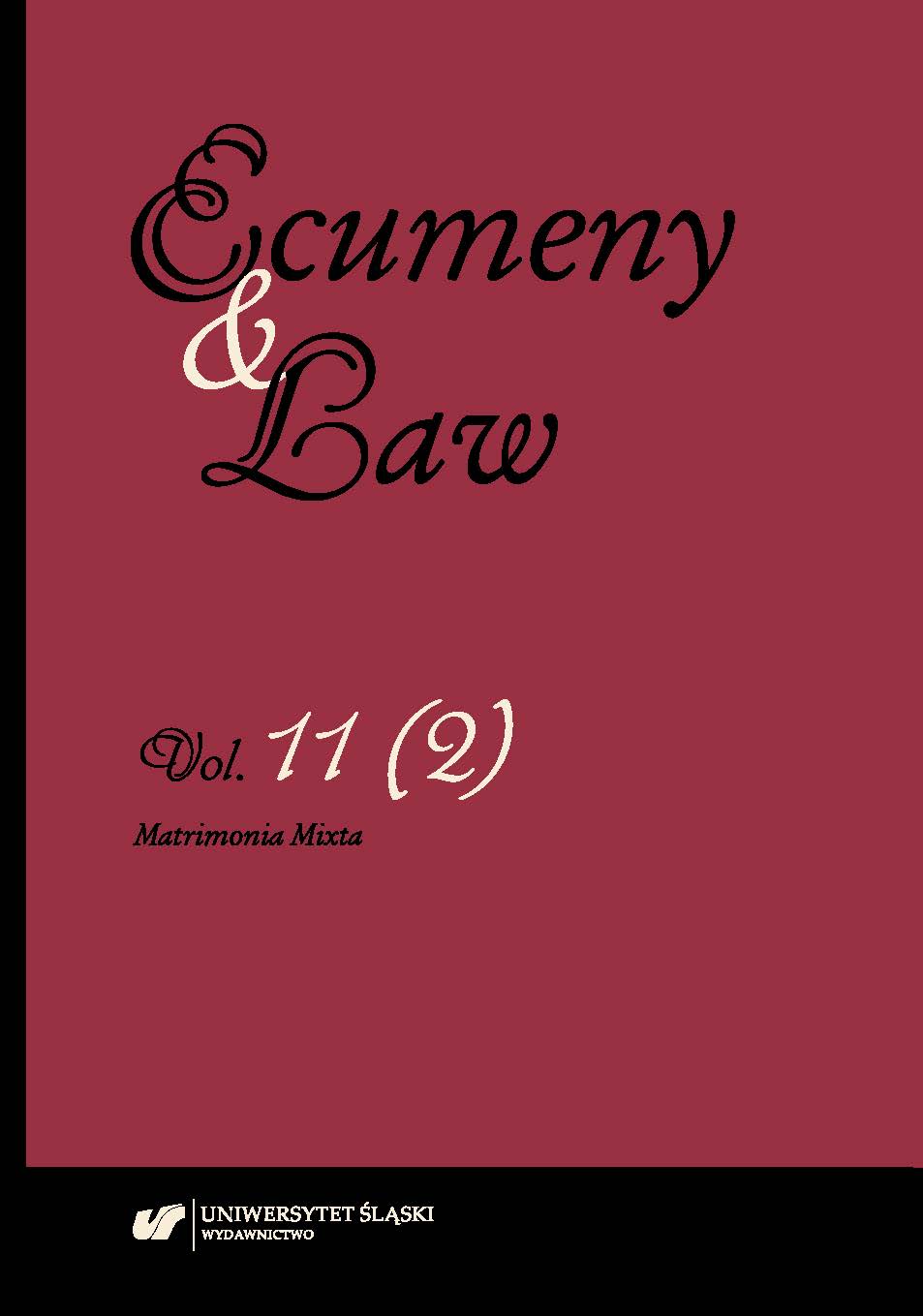Alberigo G., Dossetti J. A., Joannou P. P., Leonardi C., Prodi P.: Conciliorum oecumenicorum decreta. Bologna 2013.
Google Scholar
Ambrosius: Hexameron. Trans. J. J. Savage, available at: https://archive.org/stream/fathersofthechur027571mbp/fathersofthechur027571mbp_djvu.txt [accessed 4.10.2023].
Google Scholar
Augustinus: De bono coniugali [Of the Good of Marriage] 24, English translation available at: https://www.newadvent.org/fathers/1309.htm [accessed 4.10.2023].
Google Scholar
Berger K.: Kommentar zum Neuen Testament. Gütersloh 2011.
Google Scholar
Boumis P. I.: Kanonické právo Pravoslávnej Církvi. Prešov 1997.
Google Scholar
“Codex canonum Ecclesiarum Orientalium auctoritate Ioannis Pauli PP. II promulgatus.” Acta Apostolicae Sedis 82 (1990), pp. 1033—1363.
Google Scholar
“Codex iuris canonici auctoritate Ioannis Pauli PP. II promulgatus.” Acta Apostolicae Sedis 75, Pars II (1983), pp. 1—317.
Google Scholar
“Codex iuris canonici Pii X Pontificis Maximi iussu digestus Benedicti Papae XV auctoritate promulgatus.” Acta Apostolicae Sedis 9, Pars II (1917), pp. 5—593.
Google Scholar
Concilium Vaticanum II: “Unitatis redintegratio.” Acta Apostolicae Sedis 57 (1965), pp. 90—112.
Google Scholar
Čtyři vyznání. Vyznání augsburské, bratrské, helvetské a české se čtyřmi vyznáními staré církve a se čtyřmi články pražskými. Ed. R. Říčan. Praha 1951.
Google Scholar
Duda J.: Katolícke manželské právo. Spišská Kapitula 1996.
Google Scholar
Dvořáček J.: Východní kanonické právo. Praha 2014.
Google Scholar
Henner K.: Základy práva kanonického. Část druhá. Právo platné. Praha 1921.
Google Scholar
Hrdina I. A.: Dokumenty Tridentského koncilu. Latinský text a překlad do češtiny. Praha 2015.
Google Scholar
Kaiser M.: “Ehe zwischen konfessionsverschiedenen Partnern. ” In: Ministerium iustitiae. Festschrift für Heribert Heinemann zur Vollendung des 60. Lebensjahres. Eds. A. Gabriels, H. J. F. Reinhardt. Essen 1985, pp. 313—324.
Google Scholar
Koch G.: Sakramentenlehre II. Graz 1991.
Google Scholar
Kormaník P.: Základné sväté tajiny pravoslávnej Církvi. Prešov 1996.
Google Scholar
Leo Xiii: “Arcanum divinae sapientiae.” Acta Sanctae Sedis 12 (1879), pp. 385—402.
Google Scholar
Leppin H.: Die frühen Christen. Von den Anfängen bis Konstantin. München 2018.
Google Scholar
Migne J.-P. (accurante): Patrologiae cursus completus. Series Latina, vol. 221, Paris, 1844—1864.
Google Scholar
Müller G. L.: Katholische Dogmatik für Studium und Praxis der Theologie. Freiburg im Breisgau 1996.
Google Scholar
Ortkemper F.-J.: První list Korinťanům. Kostelní Vydří 1999.
Google Scholar
Paulus VI: “Matrimonia mixta.” Acta Apostolicae Sedis 62 (1970), pp. 257—263.
Google Scholar
Pokorný P.: Evangelium podle Marka. Praha 2016.
Google Scholar
Quasten J.: Patrologia. I primi due secoli (II–III). Casale Monferrato 2000.
Google Scholar
Sabbarese L.: Il matrimonio nell’ordine della natura e della grazia. Commento al Codice di Diritto Canonico Libro IV, Parte I, Titolo VII. Città del Vaticano 2016.
Google Scholar
Schatz K.: Všeobecné koncily. Ohniska církevních dějin. Brno 2014.
Google Scholar
Seethaler P.-A.: První a druhý list Petrův. List Judův. Kostelní Vydří 2001.
Google Scholar
Tertullianus: Ad Uxorem 7,84, http://www.tertullian.org/works/ad_uxorem.htm [accessed 4.10.2023].
Google Scholar
Thomas Aquinas: Summa Theologica. Trans. Fathers of the English Dominican Province, available at: https://www.newadvent.org/summa/5042.htm [accessed 4.10.2023].
Google Scholar
Volný V.: “Obřady uzavírání manželství v evangelických-luterských církvích.” In: W. Bugel et al.: Obřady manželství v různých liturgických tradicích. Olomouc 2013, pp. 151—156.
Google Scholar


 https://doi.org/10.31261/EaL.2023.11.2.01
https://doi.org/10.31261/EaL.2023.11.2.01

 10.31261/EaL
10.31261/EaL